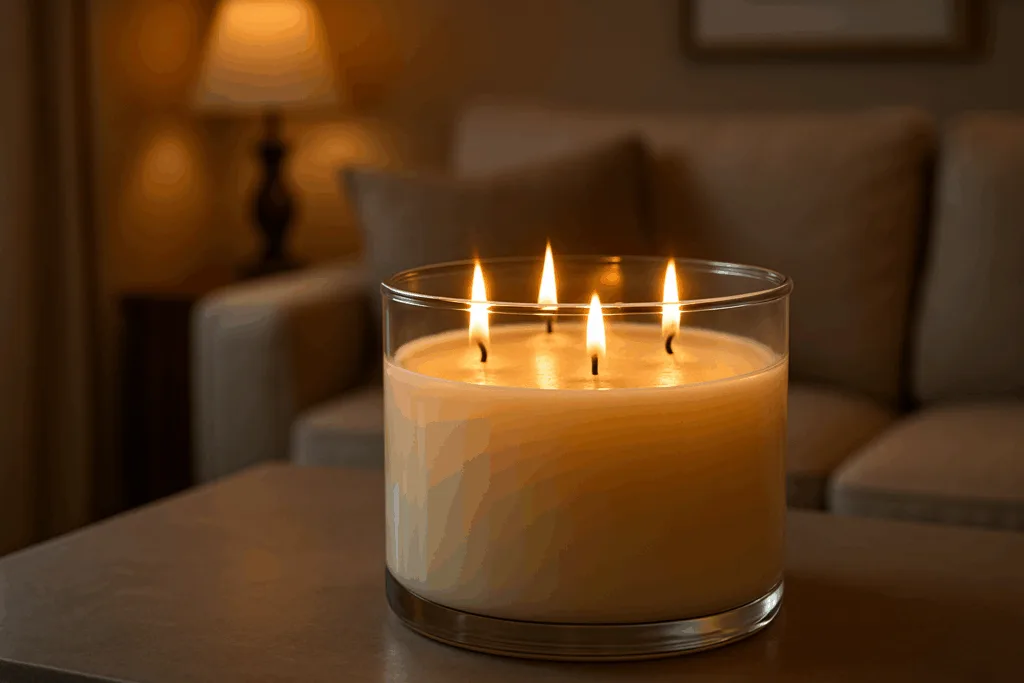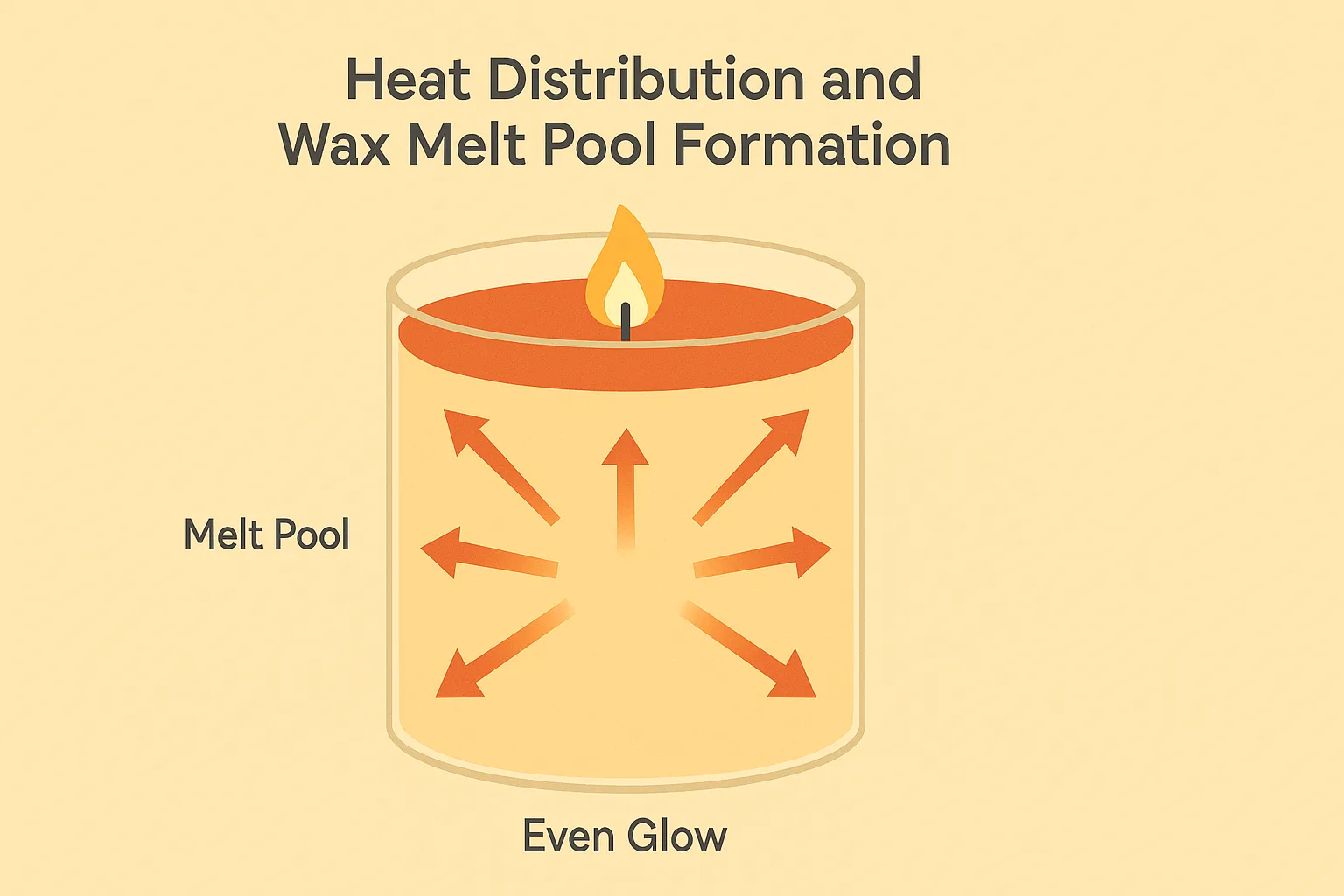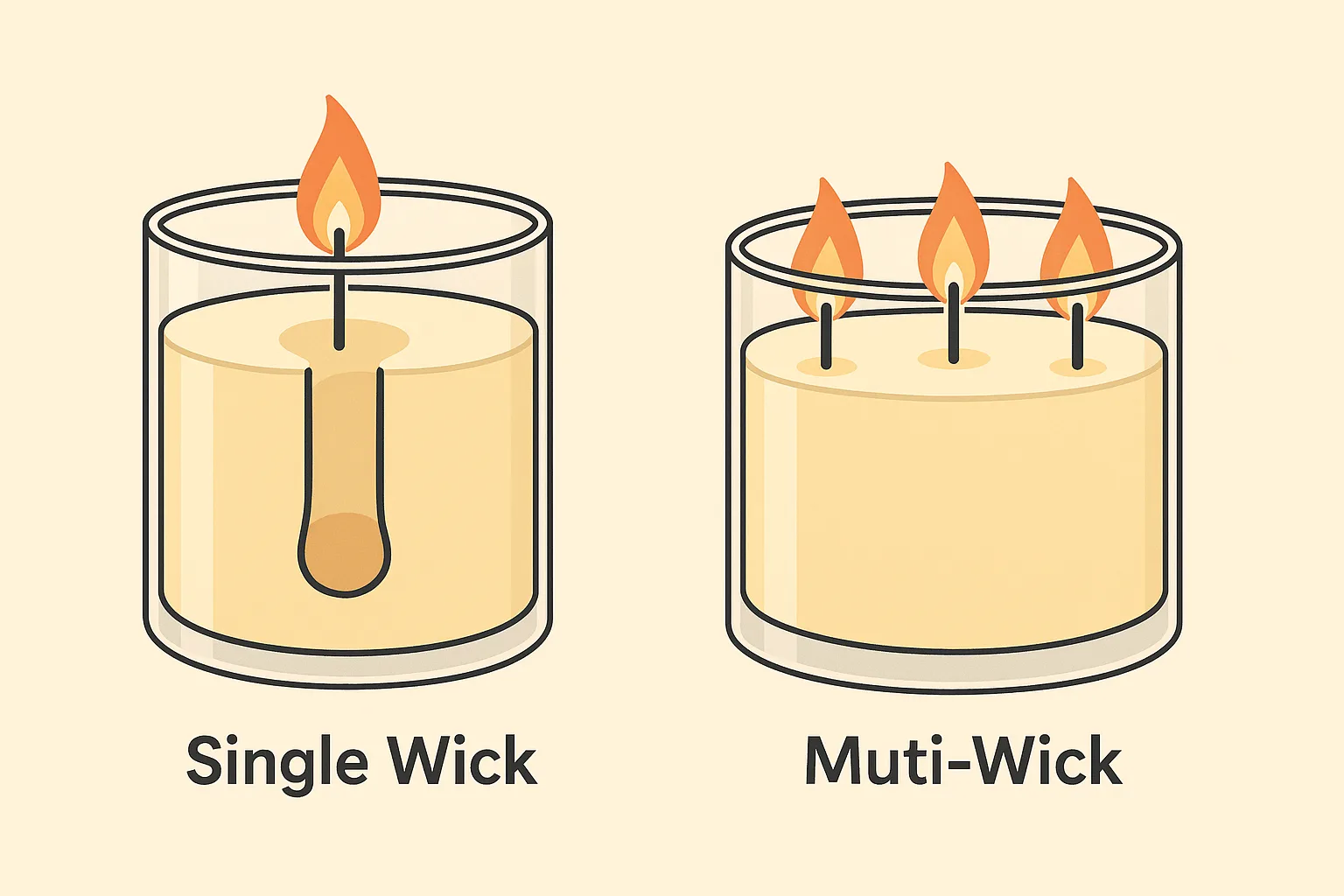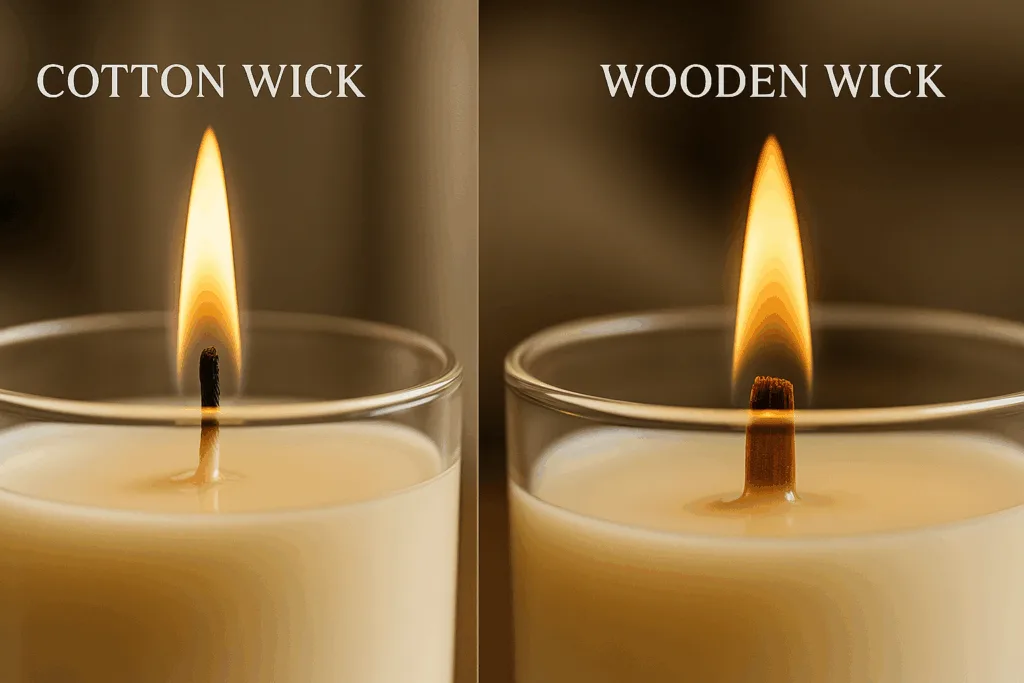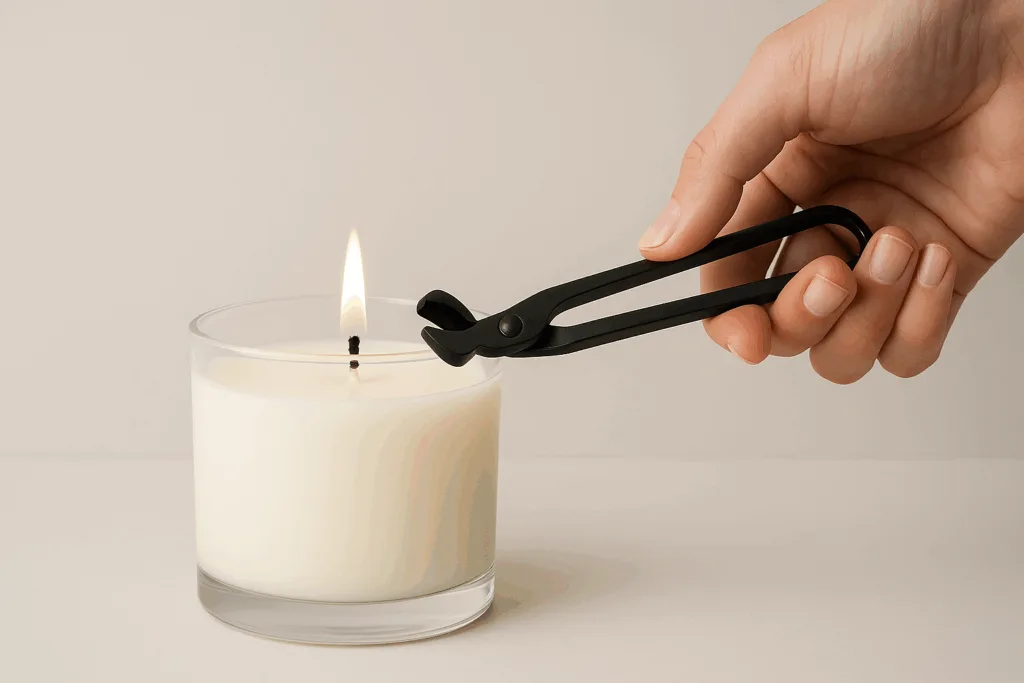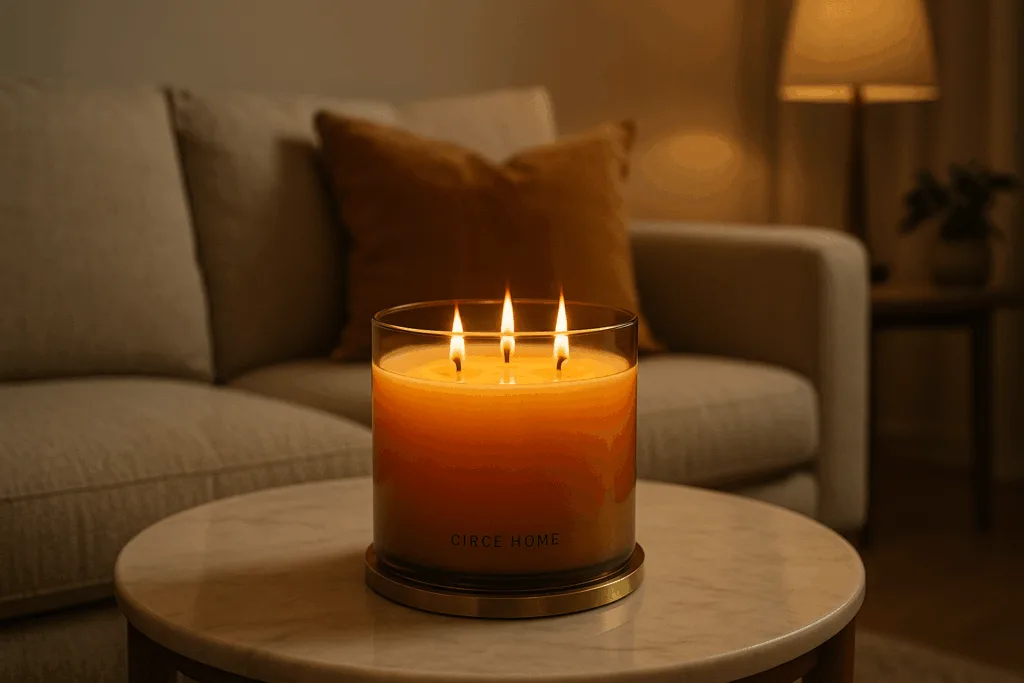Importance of Wick Configuration in Large Candles
When it comes to large candles, wick configuration is not just a technical detail—it is the very foundation of a candle’s performance. A large candle with improper wick setup often suffers from tunneling, where the wax burns down in the middle while the sides remain untouched. This not only wastes valuable wax but also shortens the candle’s lifespan. On the other hand, the right wick configuration ensures an even glow, creating a full melt pool that enhances both function and beauty.
Aesthetically, even-burning candles offer a consistent, mesmerizing light that elevates the atmosphere of any room. Practically, they maximize burn time, fragrance throw, and prevent frustrating wax waste. In comparing single-wick candles with multi-wick designs, the latter often provide superior performance in larger formats, ensuring that no part of the candle remains unused.
Understanding Candle Tunneling
Candle tunneling occurs when the flame fails to generate enough heat to melt wax across the full surface. Instead, it burns downward, forming a tunnel. This effect is especially common in wide-diameter candles where a single wick is insufficient. The consequences include:
- Wasted wax stuck on the sides of the jar.
- Reduced fragrance throw since only a small portion of wax liquefies.
- Shortened burn time, leaving customers dissatisfied.
Common mistakes leading to tunneling include using undersized wicks, not burning a candle long enough during its first use, or failing to trim the wick properly. Educating users and designing candles with the right wick setup prevents this frustrating issue.
The Science Behind Even Glow
An even glow happens when heat distribution across the candle’s surface is balanced. The key factor is the melt pool—the liquid layer of wax formed while the candle burns. For large candles, achieving a wide melt pool requires more than one wick or specially designed wick materials.
The science is simple: a candle must generate enough heat to melt wax across its full diameter. When this happens, not only does the candle burn efficiently, but it also radiates a calming, full-bodied glow. This glow enhances the ambiance of a home, making it both a sensory and emotional experience.
Wick Configuration Options
Wick configuration determines how heat spreads across the candle. Options include:
- Single-wick candles: Ideal for small jars (≤3 inches diameter).
- Double-wick candles: Effective for medium-sized jars (3–4.5 inches).
- Triple-wick or multi-wick candles: Designed for large containers (≥4.5 inches).
The number of wicks, their placement, and symmetry directly affect the melt pool. For example, a large 5-inch candle often performs best with three evenly spaced wicks.
Single-Wick Candles
Single-wick candles are simple, classic, and elegant. However, when used in wide jars, they often fail to prevent tunneling. While suitable for smaller sizes, they are not recommended for oversized candles.
Multi-Wick Candles
Multi-wick setups distribute heat evenly across a wide surface, ensuring efficient wax consumption. Double-wick candles suit medium jars, while triple-wick designs excel in larger formats. However, manufacturers must balance heat to avoid overheating and excessive wax consumption.
Innovative Wick Placements
Beyond simple symmetry, some brands experiment with offset wicks or cross-pattern designs. These allow more creative control over the burn pool and ensure consistent performance even in unconventional jar shapes.
Wick Materials and Their Role
The material of the wick impacts not only burn quality but also sustainability and brand identity.
Cotton Wicks
Cotton wicks are traditional, widely used, and versatile. They perform reliably in most wax types, but in large jars, they may need to be doubled or tripled to create a full melt pool.
Wooden Wicks
Wooden wicks offer a luxury experience. They burn wider, helping create larger melt pools, while also producing a soft crackling sound reminiscent of a fireplace. Their aesthetic and auditory appeal make them popular in premium candle collections.
Eco-Friendly Wicks
Eco-conscious consumers prefer hemp wicks or recycled fiber wicks. These alternatives are biodegradable and align with sustainable living values, making them ideal for eco-luxury candle lines.
Wick Size and Trimming Practices
Even the best wick configuration fails without proper sizing and trimming. A wick that is too long produces smoke and soot, while one too short struggles to maintain a steady flame. The ideal wick length is usually 1/4 inch (6mm). Regular trimming:
- Prevents mushrooming at the tip.
- Ensures a stable flame.
- Extends overall burn time.
For multi-wick candles, trimming all wicks evenly is essential to maintain symmetrical burning and prevent uneven melt pools.
Wax Types and Compatibility with Wick Configurations
Different waxes interact uniquely with wicks:
- Soy wax: Slower burn, often requiring multiple wicks in large jars.
- Beeswax: Dense and long-lasting, best paired with larger or wooden wicks.
- Blended waxes: Designed to optimize performance, fragrance throw, and burn time.
Choosing the right wick-wax combination is a science of balance. For example, a soy-beeswax blend may need a wooden wick to generate sufficient heat.
Designing for Aesthetic and Functionality
Luxury candles must balance form and function. A candle should:
- Burn evenly without tunneling.
- Provide a rich fragrance throw.
- Enhance the room with a warm, even glow.
By carefully designing wick configuration, Circe Home ensures its candles are not only beautiful but also long-lasting, offering consumers a complete sensory experience.
Educating Candle Users
Even the most perfectly designed candle needs proper user care. Consumers should learn:
- First-burn rule: Allow the candle to burn for 3–4 hours during its first use, ensuring a full melt pool forms.
- Avoiding drafts: Keep candles away from fans or vents to prevent uneven burning.
- Proper extinguishing: Use a snuffer instead of blowing to reduce smoke.
Brands that educate their customers build trust and reduce complaints, reinforcing their reputation for quality.
Troubleshooting Candle Tunneling
Sometimes tunneling happens despite best practices. Solutions include:
- Foil wrap method: Covering the candle with aluminum foil (leaving an opening at the top) helps redirect heat to melt the edges.
- Re-centering wicks: If a wick drifts off-center, gently reposition it after extinguishing.
- Knowing when to stop: Severely tunneled candles may not be salvageable, but partial issues can often be fixed.
Even Glow as a Branding Value
An even glow is not just a technical achievement; it is a symbol of luxury and quality. Customers who enjoy a consistently beautiful burn associate the brand with sophistication and craftsmanship. Moreover, a candle that burns to the last drop aligns with sustainability goals, reducing waste and offering better value.
Wick Configuration as a Differentiator
In a crowded candle market, wick configuration becomes a unique selling point. By offering candles that guarantee even glow and no tunneling, brands like Circe Home differentiate themselves. This allows storytelling in marketing—positioning wick design as both an art and a science.
Practical Candle Care Tips
To help customers enjoy candles to the fullest:
- Trim wicks before each burn.
- Avoid burning candles for more than 4 hours at a time.
- Store candles away from direct sunlight to preserve fragrance.
- Always place candles on a heat-resistant surface.
These simple steps extend candle life and maintain the premium experience.
The Future of Wick Design
Innovation in wick technology is shaping the next generation of luxury candles. Trends include:
- Self-trimming wicks that reduce user maintenance.
- Smart wicks that adjust burn intensity.
- Eco-engineered designs combining natural fibers with sustainability goals.
These advancements ensure that large candles continue to evolve in performance and beauty.
Conclusion
Wick configuration is both a science and an art. It determines whether a candle burns evenly, glows warmly, and provides the long-lasting enjoyment customers expect. By mastering this craft, Circe Home ensures every large candle delivers even glow, no tunneling, and a premium experience that blends sustainability, beauty, and functionality.
FAQ Section
1. Why do large candles need more than one wick?
Large candles often exceed 3 inches in diameter. A single wick cannot produce enough heat to melt the entire surface, causing tunneling. Multiple wicks ensure even burning.
2. What is the best wick length before lighting a candle?
The wick should be trimmed to about 1/4 inch (6mm). This prevents smoking, mushrooming, and uneven burning.
3. How can I fix a tunneled candle?
You can use the foil wrap method to reflect heat back onto the wax or gently re-center the wick. For severe tunneling, consider repurposing the wax.
4. Are wooden wicks better than cotton wicks?
Wooden wicks create wider melt pools and add a cozy crackling sound. Cotton wicks are versatile and reliable. The choice depends on candle size, wax type, and desired user experience.
5. Does wick configuration affect fragrance throw?
Yes. A full melt pool releases more fragrance. Multi-wick designs generally provide stronger, more consistent scent diffusion.
6. What is the first-burn rule and why is it important?
The first burn sets the memory of the wax. Burning for 3–4 hours initially ensures a complete melt pool, preventing tunneling in future burns.
7. How do wick materials impact sustainability?
Eco-friendly wicks like hemp or recycled fibers reduce environmental impact and align with sustainable living values, making them ideal for conscious consumers.

